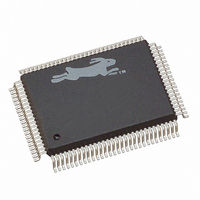20-668-0003 Rabbit Semiconductor, 20-668-0003 Datasheet - Page 140

20-668-0003
Manufacturer Part Number
20-668-0003
Description
IC CPU RABBIT2000 30MHZ 100PQFP
Manufacturer
Rabbit Semiconductor
Datasheet
1.20-668-0003.pdf
(228 pages)
Specifications of 20-668-0003
Processor Type
Rabbit 2000 8-Bit
Speed
30MHz
Voltage
2.7V, 3V, 3.3V, 5V
Mounting Type
Surface Mount
Package / Case
100-MQFP, 100-PQFP
Data Bus Width
8 bit
Maximum Clock Frequency
30 MHz
Operating Supply Voltage
0 V to 5.5 V
Maximum Operating Temperature
+ 85 C
Mounting Style
SMD/SMT
Minimum Operating Temperature
- 40 C
Number Of Programmable I/os
40
Number Of Timers
8 & 10 bit
Lead Free Status / RoHS Status
Lead free / RoHS Compliant
Features
-
Lead Free Status / Rohs Status
Lead free / RoHS Compliant
Other names
20-668-0003
316-1062
316-1062
Available stocks
Company
Part Number
Manufacturer
Quantity
Price
Company:
Part Number:
20-668-0003
Manufacturer:
Rabbit Semiconductor
Quantity:
10 000
- Current page: 140 of 228
- Download datasheet (2Mb)
applications such as Modbus require controlling gaps between characters. Thus, it would
be inadvisable to attempt Modbus with parity at a high data rate.
Other ways to add a 1-baud delay are listed below:
• Use another serial port as a timer. Disable the interrupts on the port being used to trans-
• Send a full dummy character to create a very long stop bit. To avoid the long stop bit,
• Use a timer interrupt to generate the extra 1-baud delay between characters. The inter-
• Use serial ports A and B, which have synchronous capability, to send a character in
12.7.6 Supporting 9th Bit Communication Protocols
This section describes how 9th bit communication protocols work. 9th bit communication
protocols are supported by processors such as the 8051 and the Z180, and by companies
such as Cimentrics Technology. The data bytes have an extra 9th bit appended where a
parity bit would normally be placed. Requests from the network master to one of its slaves
consist of a frame of bytes—the first byte has the 9th bit set to "1" (as the signal is
observed at the Tx pin of the processor) and the following bytes have the 9th bit set to "0."
The first byte is identified as the address byte, which specifies the slave unit where the
message is directed. This enables a slave to find the start of a message, which is the byte
with the 9th bit set, and to determine if the message is directed to it. If the message is
directed to a particular slave, the slave will then read the characters in the rest of the mes-
sage; otherwise the slave will continue to scan for a start of message character containing
its address.
Normally the 9th bit is set to "1" only on the first byte of a request transmitted by the net-
work master. The subsequent bytes and the slave replies have the 9th bit set to zero. Since
the majority of the traffic has a 9th bit set low, it is only necessary to stretch the stop bit for
the first bytes or address bytes. This can be done without sacrificing performance by send-
ing a dummy character (transmitter disconnected) after the address byte.
Some microprocessor serial ports have a “wake up” mode of operation. In this mode, char-
acters without the 9th bit set to "1" are ignored, and no interrupt is generated. When the
start of a frame is detected, an interrupt takes place on that byte. If the byte contains the
134
mit and, at the same time the data register is loaded, load a dummy character and a 9th
bit in the other serial port. The interrupt in the auxiliary port will occur after 11 baud
times rather than 10 baud times, thus guaranteeing the stop bit its full time.
the baud timer can be speeded up while the dummy character is sent to reduce the
length of the extra stop bit. The synchronous nature of timers A4–A7 allows the divide
ratio to be increased or decreased at will without generating irregular clock pulses.
rupts can be enabled for the same timer that was used to generate the baud clock, and
the timer can be slowed down so that one cycle is equal to the delay length needed.
synchronous mode (output Tx disabled). The synchronous character is sent at a baud
rate 8 times greater than the asynchronous baud rate, giving an additional baud time.
For this to work, the pin used for the synchronous clock out (port B bits 0 or 1) must
either be unconnected or connected to something that can tolerate a burst of 8 clock
pulses.
Rabbit 2000 Microprocessor User’s Manual
Related parts for 20-668-0003
Image
Part Number
Description
Manufacturer
Datasheet
Request
R

Part Number:
Description:
IC CPU RABBIT4000 128-LQFP
Manufacturer:
Rabbit Semiconductor
Datasheet:

Part Number:
Description:
IC MPU RABIT3000A 55.5MHZ128LQFP
Manufacturer:
Rabbit Semiconductor
Datasheet:

Part Number:
Description:
Microprocessors - MPU Rabbit 3000 TFBGA Microprocessor
Manufacturer:
Rabbit Semiconductor

Part Number:
Description:
Microprocessors - MPU Rabbit 4000 LQFP Microprocessor
Manufacturer:
Rabbit Semiconductor

Part Number:
Description:
IC, I/O EXPANDER, 8BIT, 40MHZ, TQFP-64
Manufacturer:
Rabbit Semiconductor

Part Number:
Description:
SCRs 1.5A 200uA 400V Sensing
Manufacturer:
Littelfuse Inc
Datasheet:

Part Number:
Description:
CARD 6-RELAY SMARTSTAR SR9500
Manufacturer:
Rabbit Semiconductor
Datasheet:

Part Number:
Description:
WIRE-BOARD CONN RECEPTACLE, 6POS, 3.96MM
Manufacturer:
TE Connectivity
Datasheet:

Part Number:
Description:
ADAPTER 20 PIN .420" PLUGS(6PCS)
Manufacturer:
Logical Systems Inc.
Datasheet:

Part Number:
Description:
CONN BARRIER BLOCK .438" 20 POS
Manufacturer:
Cinch Connectors
Datasheet:

Part Number:
Description:
20 MODII 2PC HDR DR SHRD, ROHS
Manufacturer:
TE Connectivity
Datasheet:

Part Number:
Description:
WIRE-BOARD CONN RECEPTACLE, 6POS, 3.96MM
Manufacturer:
TE Connectivity
Datasheet:














